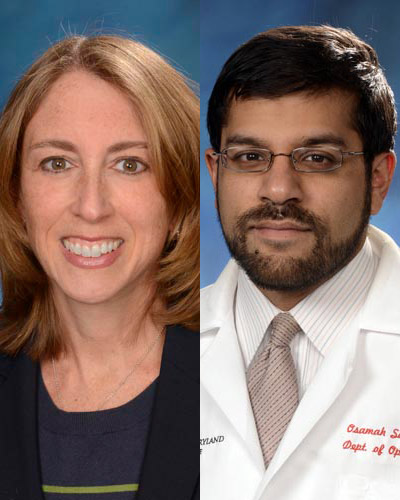December 03, 2021 | Deborah Kotz
Research Will Expand Knowledge of Open Angle Glaucoma to Hopefully Lead to Earlier Treatment for a Leading Cause of Blindness

The grant was awarded by the National Eye Institute to principal investigator Osamah Saeedi, MD, Associate Professor of Ophthalmology and Visual Sciences at UMSOM. Dr. Saeedi is also Director of the Glaucoma Division and Director of Clinical Research in the department.
Open angle glaucoma is the most common type of glaucoma, which causes irreversible blindness and vision loss. The condition affects four million Americans, many of whom do not know they have the disease until it has advanced and caused severe vision impairment. Increased pressure in the eye damages the optic nerve leading to a permanent loss of nerve cells. Vision loss from glaucoma results from progressive damage to the optic nerve. While lowering eye pressure is the only available treatment, poor blood flow to the eye and nerve cells in the eye is also associated with the disease.
“There is strong evidence that impaired blood flow is involved in the development and progression of primary open angle glaucoma,” said Dr. Saeedi. “We aim to see what role this may play in the loss of neurons in the optic nerve and retina that are vital for vision.”

Dr. Saeedi and his FDA collaborators will employ the use of innovative imaging modalities to measure retinal blood flow down to the level of the individual red blood cell. They will be using sophisticated laser imaging technologies called erythrocyte mediated angiography flowmetry (EMAf) and multimodal adaptive optics (mAO). Both techniques allow for the highly accurate and precise measurement of retinal blood flow, even in tiny capillaries.
“The adaptive optics system in our FDA laboratory uses an imaging mode called optical coherence tomography, which is similar to what is used in some ophthalmic clinics, but unlike those systems, we’re able to achieve cellular-level resolution,” said Dr. Hammer.
An example of cellular-level resolution – imaging retinal ganglion cells in the inner retina – was pioneered by Dr. Liu in her post-doctoral work at Indiana University. Building upon that previous work, the UMSOM-FDA team hopes to image both cells and capillaries important in the progression of the disease.

This study will compare blood flow in the eyes of 60 glaucoma patients with a control group of 30 volunteers who do not have glaucoma. They researchers hypothesize that those in the early stages of glaucoma will have a significant impairment in their retinal blood flow compared to those who do not have glaucoma.
“Identifying precise biomarkers for early stage glaucoma is vital for detecting this disease at its earliest stage before it causes permanent vision loss,” said E. Albert Reece, MD, PhD, MBA, Executive Vice President for Medical Affairs, UM Baltimore, and the John Z. and Akiko K. Bowers Distinguished Professor and Dean, University of Maryland School of Medicine. "This translational research study will hopefully provide a robust new direction for developing new tests and treatments for this leading cause of blindness.”
About the University of Maryland School of Medicine
Now in its third century, the University of Maryland School of Medicine was chartered in 1807 as the first public medical school in the United States. It continues today as one of the fastest growing, top-tier biomedical research enterprises in the world -- with 46 academic departments, centers, institutes, and programs, and a faculty of more than 3,000 physicians, scientists, and allied health professionals, including members of the National Academy of Medicine and the National Academy of Sciences, and a distinguished two-time winner of the Albert E. Lasker Award in Medical Research. With an operating budget of more than $1.2 billion, the School of Medicine works closely in partnership with the University of Maryland Medical Center and Medical System to provide research-intensive, academic and clinically based care for nearly 2 million patients each year. The School of Medicine has nearly $600 million in extramural funding, with most of its academic departments highly ranked among all medical schools in the nation in research funding. As one of the seven professional schools that make up the University of Maryland, Baltimore campus, the School of Medicine has a total population of nearly 9,000 faculty and staff, including 2,500 students, trainees, residents, and fellows. The combined School of Medicine and Medical System (“University of Maryland Medicine”) has an annual budget of over $6 billion and an economic impact of nearly $20 billion on the state and local community. The School of Medicine, which ranks as the 8th highest among public medical schools in research productivity (according to the Association of American Medical Colleges profile) is an innovator in translational medicine, with 606 active patents and 52 start-up companies. In the latest U.S. News & World Report ranking of the Best Medical Schools, published in 2021, the UM School of Medicine is ranked #9 among the 92 public medical schools in the U.S., and in the top 15 percent (#27) of all 192 public and private U.S. medical schools. The School of Medicine works locally, nationally, and globally, with research and treatment facilities in 36 countries around the world. Visit medschool.umaryland.edu
Contact
Deborah Kotz
University of Maryland Medicine
dkotz@som.umaryland.edu
(410) 706-4255
Related stories

Wednesday, April 27, 2022
UMSOM Names Noted Faculty-Scientists, Dr. Lisa Schocket and Dr. Osamah Saeedi, To Leadership Appointments in Department of Ophthalmology
UMSOM Dean E. Albert Reece, MD, PhD, MBA, announced today that two senior faculty members in the Department of Ophthalmology and Visual Sciences have been named to leadership positions.

